Wiki
Clone wikiProject Team / 230
Project Team version 2.3.0
The content of this page applies to the following version(s) of Project Team:
- v. 2.3.0 for JIRA 5.1 to 5.2.11
On this page:
What's new in this version?
- User Custom Fields
Starting with this version you can extend the profile of your team members by adding user custom fields. The custom fields and their values are displayed on the Project Team tab next to the other user attributes.
The team members can set their values of these custom fields on the Project Team tab of a project. Also, the JIRA Project Admin (or project lead) of a project can change the values of these custom fields for all the team members of that project.
The user custom fields can be added in the add-on's administration area and their type can be Text or Multi Value Picker. The Text custom fields are suitable for mapping simple text attributes like Phone Number or Skype ID. The Multi Value Picker fields can be used for mapping multi-value attributes like Technical Skills or Foreign Languages because they allow users to select one or more options from a list.

- The total number of role members displayed in the Project Team table
The total number of the role members is now displayed on the Total Members column of the Project Team table, in By roles display mode.
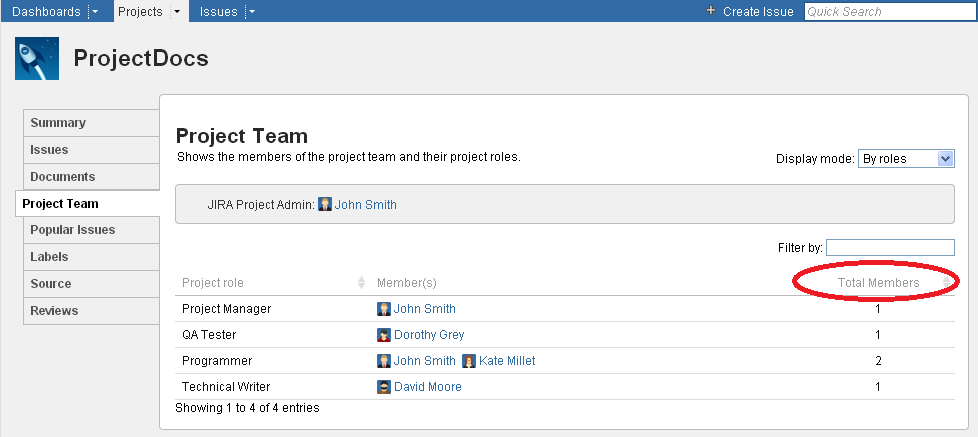
What Project Team does?
The add-on adds a new tab named "Project Team" to the JIRA projects on which the team members are displayed along with their project roles as they are defined and configured by the JIRA or project admin. Also, it allows you to extend the profile of your team members by adding user custom fields. The custom fields and their values are displayed on the Project Team tab next to the other user attributes.
The team can be displayed in two different modes, depending on the user's selection.
Project team displayed by members
In this mode each team member is listed along with its full name, username, avatar, email address, project role(s) and the user custom fields defined by the JIRA administrator. You can click the username to see the profile of the user.
You can sort the data in the table by clicking a column header. Also, the data can be filtered by typing a text in the Filter by field.
This mode is used when Display mode is set to By members.
The size of the avatar (small or large) can also be changed in the add-on configuration page (see Configuring the add-on settings).
JIRA Project Admin displayed on top of the page represents the JIRA project lead - an user that usually has admin rights over the project and can, for instance, add new components or new versions to the project. The JIRA administrator can choose to display (or not to display) the JIRA Project Admin via add-on configuration settings.
Project team displayed by project roles
In this mode each role defined in the project is listed along with its members. You can click the username to see the profile of the user.
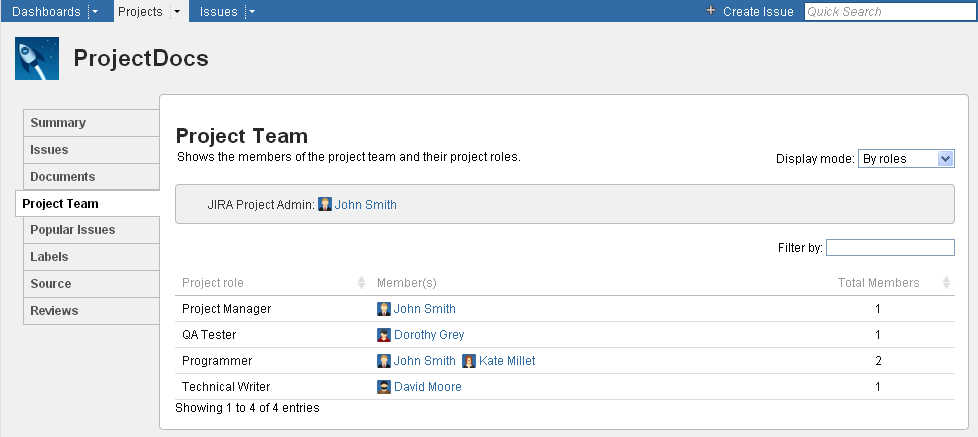
You can sort the data in the table by clicking a column header. Also, the data can be filtered by typing a text in the Filter by field.
This mode is used when Display Mode is set to By roles.
JIRA Project Admin displayed on top of the page represents the JIRA project lead - an user that usually has admin rights over the project and can, for instance, add new components or new versions to the project. The JIRA administrator can choose to display (or not to display) the JIRA Project Admin via add-on configuration settings.
The Total Members column indicates the number of members belonging to each project role.
Changing the display mode
The user can change the display mode via the Display mode dropdown list from the top-right corner of the Project Team project tab.
If the user never changed the display mode, the default display mode configured in the Add-on Configuration Settings page is used.
Setting the value of the user custom fields
If the display mode is set to By members, the team members can set their values of the custom fields by moving the mouse over the field and clicking the link displayed.

When choosing to set the value of a custom field of type Text, a window like in the picture bellow is displayed:

When choosing to set the value of a custom field of type Multi Value Text, a window like in the picture bellow is displayed:
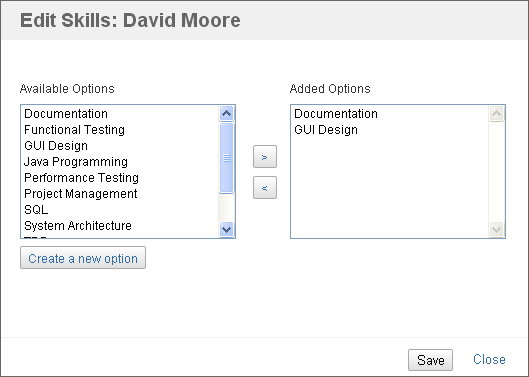
In this window the team member can select one or more options from the Available Options list and add them to the Selected Options list by clicking the ">" button. The user can add a new option to the Available Options list, in case it does not already exist, by clicking the Create a new option button.
NOTE The JIRA Project Admin of a project can change the value of these custom fields for all the team members of that project.
Installing Project Team
Project Team is a deployable add-on, composed of a single JAR file, which can be installed directly from the Universal Plugin Manager (UPM).
But if you manually downloaded the JAR file by accessing the add-on's Download link from Marketplace, follow the next steps to install it:
- Log on to JIRA as an administrator
- Go to Administration
- Go to Plugins menu and click Plugins to open UPM page
- Go to Install tab
- Click Upload Plugin
- Select the JAR file of Project Team
- Click Upload to start the installation. When the installation is done, a confirmation message is displayed.
The add-on is not fully functional at this time. You must obtain and activate a trial or commercial license in order to use Project Team. See Activating the add-on license.
Activating the add-on license
In order to run the Project Team add-on you need a trial or a commercial license. You can purchase Project Team from the Marketplace or through the Universal Plugin Manager (UPM). Once you obtained a license code you must activate it. License activation steps depend on the version of Universal Plugin Manager (UPM) installed on your JIRA instance.
License activation when UPM is 2.0 or newer
If you have Universal Plugin Manager (UPM) 2.0 or newer, follow the next steps to activate Project Team license:
- Log on to JIRA as an administrator
- Go to Administration
- Go to Plugins menu and click Plugins to open UPM page
- Locate and expand the Project Team add-on under User-installed Plugins
- Enter the license code in the Enter the new license field
- Click Update. If your license is valid, a confirmation message is displayed on top of the page.
License activation for an earlier version than UPM 2.0
If you have a version of Universal Plugin Manager earlier than 2.0, follow the next steps to activate Project Team license:
- Log on to JIRA as an administrator
- Go to Administration
- Go to Plugins menu and click Licensing under Project Team Add-on Configuration
- On the Licensing tab enter the license code in the Enter the new license field
- Click Update. If your license is valid a confirmation message is displayed on top of the page.
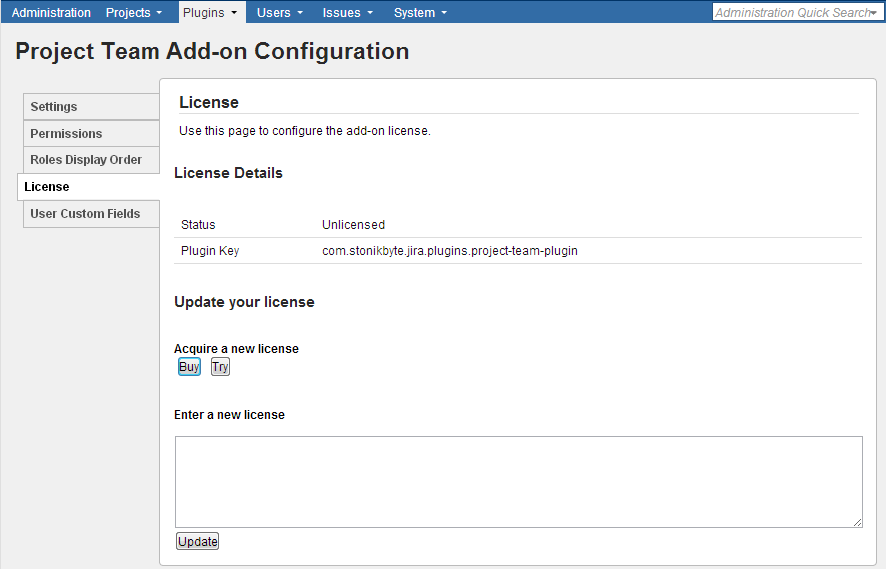
Configuring the add-on settings
To configure the Project Team add-on settings follow the next steps:
- Log on to JIRA as an administrator
- Go to Administration
- Go to Plugins menu and click Settings under Project Team Add-on Configuration
- On the Settings tab, change the settings to suit your preferences. See the table below for a complete description of the available settings.
- Click Save to apply the settings
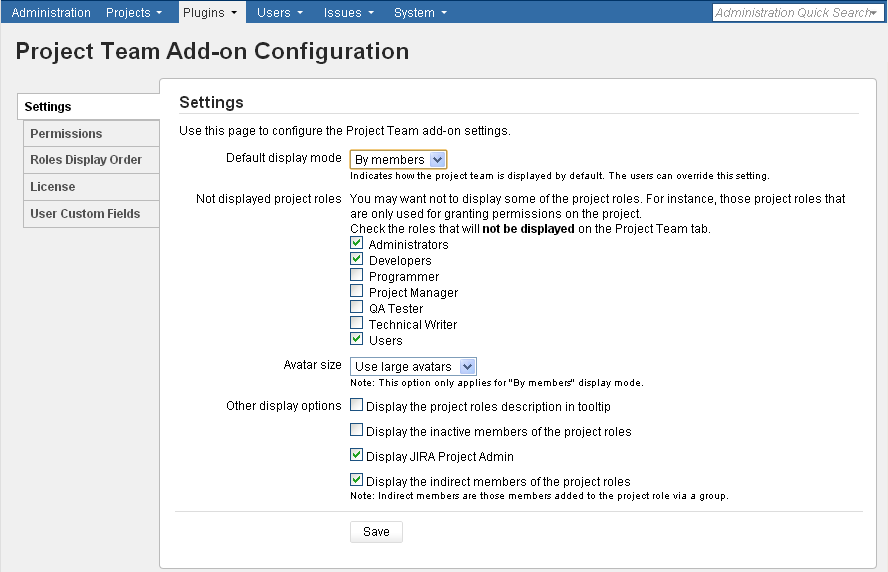
| Item | Description |
|---|---|
| Default display mode | This option indicates how the team is displayed on the Project Team tab if a display mode was not yet selected by the user. There are two options available: By members – displays the members of the team along with their e-mail address and project roles. This is the default option. By roles – displays the roles of the project and their members. |
| Not displayed project roles | You may not want to display some of the project roles. For instance, those project roles that are only used for granting permissions over the project or for notification schemes. Check the roles that you don’t want to be displayed on the Project Team tab. All the project roles defined in JIRA are listed. |
| Avatar size | Choose between using large or small avatars. The default value is Use large avatars. This option only applies when the current display mode is set to By members. |
| Other display options | Check Display the project roles description in tooltip if you want the description of the project role to be displayed in a tooltip when the user moves the mouse pointer over a project role. This option is by default unchecked. Check Display the inactive members of the project roles if you want the inactive (deactivated) JIRA users that are members of a project role to be shown on the Project Team tab. This option is by default unchecked. Check Display JIRA Project Admin if you want the JIRA Project Admin (project lead) to be displayed on top of the Project Team tab. This option is by default checked. Check Display the indirect members of the project roles if you want the indirect members to be shown on the Project Team tab. Indirect members of a project role are those members that were added to the role via a group. This option is by default checked. |
Configuring the add-on permissions
By default anyone can visualize the "Project Team" tab of a project. You can restrict the access to the "Project Team" tab through add-on permissions configuration. Follow the next steps to configure the add-on permissions:
- Log on to JIRA as an administrator
- Go to Administration
- Go to Plugins menu and click Permissions under Project Team Add-on Configuration
- On the Permissions tab, check the project roles that are allowed to View the "Project Team" tab.

- Click Save to apply the changes.
NOTE If a JIRA user is member of a project role that has View permission but he/she is also member of another project role that does not have the View permission, it is considered that the user in question has View permission.
Configuring roles display order
You can specify the order in which the project roles are displayed. For instance, you can choose to display the Project Manager or Product Owner on the top of the Project Team tab, followed by the other team members and roles. All you have to do is add these roles and set their order in the new Roles Display Order section from the add-on configuration.
Follow the next steps to configure the roles display order:
- Log on to JIRA as an administrator
- Go to Administration
- Go to Plugins menu and click Roles Display Order under Project Team Add-on Configuration
- On the Roles Display Order tab, use the Add button to add the roles to the list.
- Use the up/down arrows to set the roles order
- You can remove a role from the list by checking the box next to it and then clicking Remove
- Click Save to apply the changes.
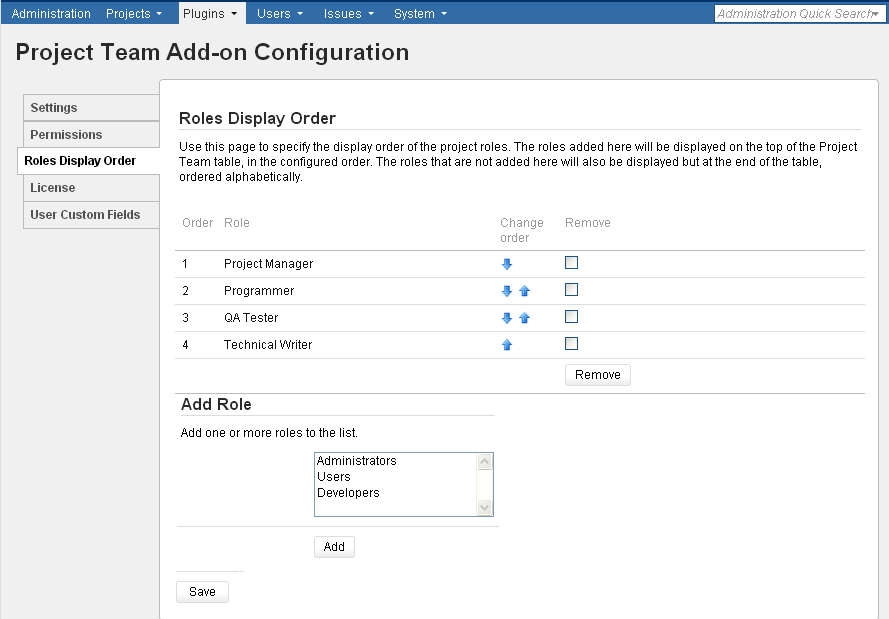
NOTE The roles added here and their members will be displayed on the top of the Project Team table, in the configured order. The roles that are not added here will also be displayed but at the end of the table, ordered alphabetically.
Configuring user custom fields
You can extend the profile of your team members by adding user custom fields. The custom fields and their values are displayed on the Project Team tab next to the other user attributes.
The team members can set their values of these custom fields on the Project Team tab of a project. Also, the JIRA Project Admin (or project lead) of a project can change the value of these custom fields for all the team members of that project.
The user custom fields can be added in the add-on's administration area and their type can be Text or Multi Value Picker. The Text custom fields are suitable for mapping simple text attributes like Phone Number or Skype ID. The Multi Value Picker fields can be used for mapping multi-value attributes like Technical Skills or Foreign Languages because they allow users to select one or more options from a list.

Adding a user custom field
Follow the next steps to add a user custom field:
- Log on to JIRA as an administrator
- Go to Administration
- Go to Plugins menu and click User Custom Fields under Project Team Add-on Configuration
- On the User Custom Fields tab, click the Add Custom Field button. The Add User Custom Field screen is displayed.
- Select the Type of the custom field. You can choose between Text and Multi Value Picker.
- Type a Name for the new field. The Name is required and must be unique.
- You can enter a Description for the new field. The description is optional.
- If you chose to add a field of type Multi Value Picker, you can enter the input options of the field in the Add Input Options table. The input options can also be added later, by editing the custom field. So it is not required to add all the input options during the field creation.
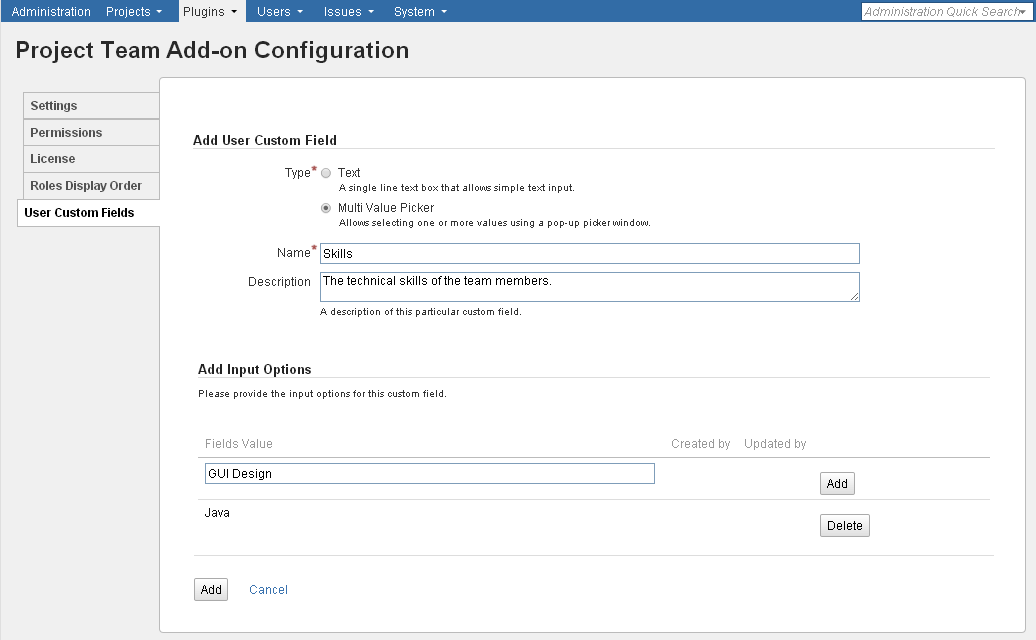
- When you are done, click the Add button from the bottom of the page to add the new custom field. Once added, the new field is listed in the table from the User Custom Fields tab and it also appears as a new column in the table from the Project Team tab of the JIRA projects.
Editing a user custom field
Follow the next steps to edit a user custom field:
- Log on to JIRA as an administrator
- Go to Administration
- Go to Plugins menu and click User Custom Fields under Project Team Add-on Configuration
- On the User Custom Fields tab, click the icon from the row corresponding to the field that you want to edit.

- Click the Edit menu-option. The Edit User Custom Field screen is displayed.
- Change the attributes of the custom field as you wish.
- If the field is of type Multi Value Picker, you can edit the input options of the field in the Edit Input Options table.
- When you are done, click the Save button from the bottom of the page to save the changes you made.
Deleting a user custom field
Follow the next steps to delete a user custom field:
- Log on to JIRA as an administrator
- Go to Administration
- Go to Plugins menu and click User Custom Fields under Project Team Add-on Configuration
- On the User Custom Fields tab, click the icon from the row corresponding to the field that you want to delete.

- Click the Delete menu-option. A pop-up message is displayed asking if you are sure that you want to delete that field.
- If you are sure that you want to delete the custom field, click Delete to delete it. Otherwise, click Cancel.
Updated